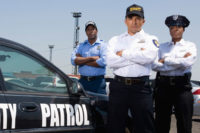De-Escalating Sports Venue Conflicts with the Right Tools

If you’ve never considered the safety risks of a professional security officer, placing them in a sporting venue where they are significantly outnumbered is an excellent research lab. Because of the sheer quantity of people, the passion for their teams and the possibility of alcohol consumption, sports leagues, such as the Fédération Internationale de Football Association (FIFA), recommend one security officer for every 250 visitors in a venue, while some high schools recommend one officer for every 50 students. Assigning the proper number of security personnel is a delicate balance of operational efficiency, cost and visitor safety, which makes proper equipment for the job an essential consideration.
There are a number of sensible options available for security officers to achieve “enhanced presence” with non-lethal tools. The tools should be appropriate for the officer’s role and improve the ability to perform their duties. Consider this: If your officers carry handcuffs, what other tools do they have to control an individual while attempting to cuff that person? If your answer is “nothing,” keep reading.
Tools for The Job
Distance + Time = Safety. For security professionals, this is an important equation, particularly when considering what tools are available on their duty belts. The tools should help maximize the time an officer has to react to a threat while keeping that threat at a safe distance. Here is a look at the benefits and drawbacks of tools available today to security professionals:
- Enhanced Non-Lethal (ENL) – ENLs are an emerging category of economical tools that combine two or more non-lethal capabilities, as well as an integrated communication or alerting platform. For example, an ENL can combine pepper spray, a disorienting strobe light and a Bluetooth® communication module that automatically calls a central desk or field supervisor for support when it’s needed. Products in this category can engage a threatening person at distances of 10 feet and provide a security officer with an ability to remove a disruptive visitor without placing others at risk.
- Conducted Energy Weapon (CEW) – There is a significant difference between contact stun devices and neuromuscular incapacitation (NMI) devices built for law enforcement. Both are in the CEW category, but contact stun devices require your staff to get within arm’s reach of an aggressive visitor before they can engage them. Generally speaking, this is a poor tactic. If you are evaluating CEWs, understand that your security team may be deploying a CEW as a tactical tool in a situation that is edging out of control.
- Batons – While batons have been in use for years, technology has improved their balance and striking power. The operating principle of a baton is simple: intimidation and/or the physical destruction of tissue and bones. Batons are low-cost and effective, but the chance your security officer may accidentally deliver a fatal head strike could be too much risk for your venue to absorb. Consider them, but understand that pictures of an effective baton strike could be the centerpiece of a plaintiff’s case against your staff, team owners and venue operators.
- Pepper Spray – By some estimates, nearly 30 percent of security officer currently carry pepper spray as a defensive tool. Pepper spray is popular because, by spraying the active ingredient oleoresin capsicum (O.C.), it provides an inexpensive incapacitation capability. The risks associated with deploying pepper spray are generally low and can be overcome with excellent training and regular refresher courses. Training is essential to ensure proper aiming technique, because pepper spray deployed excessively (for two- to three-second bursts) can affect innocent bystanders.
Arming Sporting Venue Security Professional
When considering what devices officers need on their tool belts, here are some guidelines to ensure that your decisions are sensible, tactically sound and cost effective:
- Collaborate with your security chief, stakeholders and C-Suite in defining the role of your security officers and the risks they face;
- Enable your officers to meet threats with an appropriate response;
- When possible, maximize the distance at which your security personnel can engage a threat;
- Budget for annual training at minimum, but quarterly is preferred;
- Review training materials to ensure they address risks unique to your venue; and
- Enable thorough reporting of incidents, and include images and audio.
When choosing the tools for your security officer’s duty belt, remember that there isn’t a perfect tool for every situation. A smart strategy would be to encourage the use of products that provide a layered defense for your officer and protect your venue against frivolous lawsuits. By selecting the right tools, your officers will have more satisfaction in their job, resulting in lower turnover, less risk and reduced operating costs.
Looking for a reprint of this article?
From high-res PDFs to custom plaques, order your copy today!





